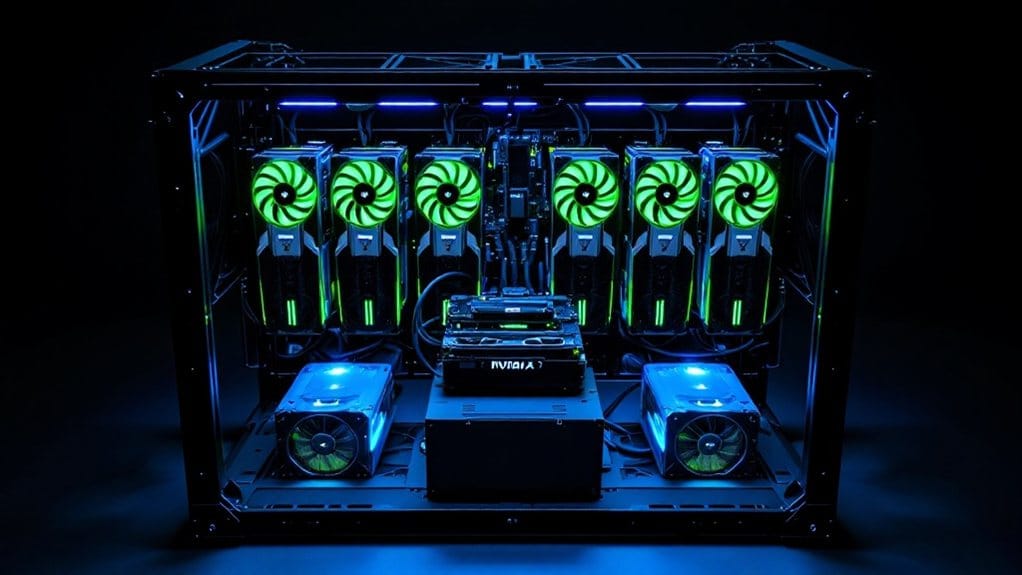NFT fashion merges blockchain technology with digital design, creating unique virtual garments authenticated through secure distributed ledgers. These digital wearables enable consumers to own and showcase fashion pieces across metaverse platforms and virtual environments, while designers benefit from direct sales and guaranteed royalties through smart contracts. The technology eliminates physical waste, supports sustainable practices, and allows for physics-defying designs impossible in traditional fashion. This transformative medium opens new possibilities for creative expression and digital ownership in the fashion industry.

As the digital fashion landscape continues to evolve, NFT (Non-Fungible Token) fashion has emerged as a groundbreaking intersection of blockchain technology and creative design, transforming how consumers interact with clothing in virtual spaces. These unique digital assets, authenticated through blockchain technology, enable users to own and showcase virtual garments in metaverse environments, digital platforms, and virtual reality spaces, while maintaining verifiable ownership records. Virtual try-on features allow users to preview and experiment with digital fashion pieces before making purchase decisions.
Major fashion houses, including Dolce & Gabbana, have recognized the potential of NFT fashion, investing in digital collections that combine traditional design aesthetics with innovative technological capabilities. The technology allows designers to create intricate, physics-defying garments that would be impossible to produce physically, while simultaneously reducing environmental impact through the elimination of material waste and production costs associated with traditional fashion manufacturing. Limited edition drops create heightened demand and desirability among collectors.
NFT fashion enables impossible designs while eliminating physical waste, revolutionizing how luxury brands approach digital creativity and sustainable manufacturing.
NFT fashion presents significant advantages for both creators and consumers, establishing a direct-to-consumer sales model that bypasses traditional retail intermediaries. Similar to traditional art markets, transparent ownership ensures authenticity and prevents counterfeiting in the digital fashion space. Designers can track consumer behavior through blockchain data, enabling targeted marketing strategies and improved engagement with their audience.
The digital nature of these assets allows for global distribution without logistical constraints, while smart contracts guarantee creators receive royalties from subsequent market sales.
The sustainability benefits of NFT fashion extend beyond waste reduction, contributing to a more circular economy through digital reuse and dematerialization. Virtual fashion items can be traded, collected, and customized without consuming physical resources, offering an environmentally conscious alternative to fast fashion consumption patterns.
The technology’s energy efficiency in digital transactions and storage further reinforces its potential as a sustainable fashion solution.
Consumer engagement with NFT fashion is driven by accessibility, unique identity expression, and social interaction within virtual environments. Users can create, customize, and collect digital garments, fostering community engagement through shared experiences and exclusive events.
The technology democratizes fashion access while maintaining the exclusivity and authenticity traditionally associated with luxury brands, creating a new paradigm for fashion consumption in the digital age.
FAQs
Can NFT Fashion Items Be Traded for Real-World Clothing Pieces?
Currently, direct trading of NFT fashion items for physical clothing pieces is not standardized in the market.
However, some brands have implemented hybrid models where NFT ownership grants access to exclusive physical merchandise or experiences.
For example, luxury brands like Gucci and Nike have experimented with NFT collections that include both digital assets and corresponding physical items, though these typically operate as separate but related purchases rather than direct trades.
How Do Fashion Brands Verify the Authenticity of Their Digital NFT Collections?
Fashion brands verify their digital NFT collections through a multi-layered authentication system.
The process utilizes blockchain technology to create immutable records of ownership, while smart contracts manage secure transactions and transfers.
Brands implement QR codes and NFC chips to link physical items with their digital counterparts, while specialized smartphone apps enable consumers to scan and verify authenticity through marketplace validation and metadata verification.
What Software Do I Need to Create My Own NFT Fashion Designs?
Creating NFT fashion designs requires a combination of specialized software tools.
Adobe Photoshop and Illustrator serve as foundational programs for 2D design work, while CLO 3D and Marvelous Designer enable realistic 3D garment simulation.
For detailed texture work, ZBrush proves crucial, and Blender offers extensive 3D modeling capabilities.
Moreover, platforms like Ethereum or Polygon are required for minting the final NFT designs.
Are NFT Fashion Items Compatible Across Different Virtual Platforms and Games?
NFT fashion items’ cross-platform compatibility differs greatly based on established partnerships and technical protocols.
While major brands like Adidas and Gucci have developed interoperable NFTs that function across multiple platforms, many digital wearables remain platform-specific.
The implementation of blockchain-agnostic protocols and common standards is gradually improving compatibility, allowing users to showcase their digital fashion items across diverse virtual environments, gaming platforms, and metaverse spaces.
How Do NFT Fashion Creators Protect Their Designs From Unauthorized Copying?
NFT fashion creators employ multiple layers of protection for their digital designs.
Smart contracts embedded in blockchain technology establish immutable ownership records, while trademark registrations safeguard brand identity.
Creators actively monitor platforms for unauthorized copies, issuing takedown notices when infringement occurs.
Furthermore, detailed documentation of the design process, including timestamps and metadata, provides vital evidence for legal disputes, while collaboration with platform owners strengthens enforcement capabilities.









